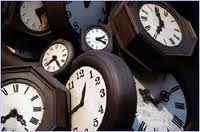Initially we discussed the idea of simply dressing head-to-toe in white, this was due to the fact that we wanted to look somewhat conformed, like part of a machine. By identifying ourselves as the same through the use of costumes, we were putting forth the idea that we were all of the same practicality, becoming arguable similar to that of a clocks cogs. If we were to settle on this idea, it would not have been just for aesthetic purposes, but practicality also. Due to the fact that we have planned for a number of projections to play throughout our piece, we experimented with the idea of projecting them onto ourselves, which lead us to the colour white.
After careful consideration, we decided against this idea. Rather than projecting onto ourselves, we were given the opportunity to close off the gallery next door to the one in which we are working in, meaning we now have a solid flat surface to project our ideas onto. Unfortunately the closed door is in keeping with Gallery 3’s colour scheme, along with the carpet it is a midnight blue. This leaves us with the options of covering it and projecting onto either tracing paper or a white bed sheet/blind. As we have a reasonably large surface area to cover, it will be much more practical to use one bed sheet opposed to multiple pieces of tracing paper.
As our piece began to develop our ideas on costumes changed to accommodate the structure which we set ourselves. As many of you already know, we are doing a 6 hour duration piece (during the galleries opening hours 10-4pm), within this we will be performing a ‘micro-day.’ Each hour will represent a different part of the day in which we use repetitive actions to the ticking of a clock, to represent the key moments in everyday life (see previous post ‘A Micro Day’ for more details), this will show our process of experimentation with the use of time manipulation. Each ‘actor’ will be wearing a different level of clothing:
1. Underwear
2. Pyjamas
3. Overalls (work clothes)
4. Suit (again, work attire)
5. Casual/Lounge outfit
6. Dressed up/Going out
This choice, in itself, demonstrates an element of time. During the duration of a standard day, the average person will at some point make a transition through the clothing I have listed above. As we have also incorporated each costume with a set time of day, it will become clear to the spectators that although the actors may look out of place for the majority of the performance, they will fit perfectly into at least one set time. Our choice of performance space (gallery 3) features cases full of crockery and pocket watches, which can be considered to be domesticated applied art. By dressing ourselves in ‘domesticated’ outfits, we are attempting to transform ourselves into a part of that already present art, in keeping with both the themes of time and the domestic.
Author: Chloe Doherty


